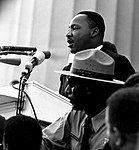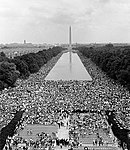Arlington Memorial Bridge

The Arlington Memorial Bridge is a Neoclassical masonry, steel, and stone arch bridge with a central bascule (or drawbridge) that crosses the Potomac River at Washington, D.C., the capital of the United States. First proposed in 1886, the bridge went unbuilt for decades thanks to political quarrels over whether the bridge should be a memorial, and to whom or what. Traffic problems associated with the dedication of the Tomb of the Unknown Soldier in November 1921 and the desire to build a bridge in time for the bicentennial of the birth of George Washington led to its construction in 1932. Designed by the architectural firm McKim, Mead, and White, decorated with monumental statues depicting valor and sacrifice by sculptor Leo Friedlander, cast by Ferdinando Marinelli Artistic Foundry, Florence, Italy, Arlington Memorial Bridge defines the western end of the National Mall. The bridge's draw span was permanently closed in 1961 and replaced in 2018 by one that does not open.
Excerpt from the Wikipedia article Arlington Memorial Bridge (License: CC BY-SA 3.0, Authors, Images).Arlington Memorial Bridge
Arlington Memorial Bridge, Washington
Geographical coordinates (GPS) Address External links Nearby Places Show on map
Geographical coordinates (GPS)
| Latitude | Longitude |
|---|---|
| N 38.887222222222 ° | E -77.055555555556 ° |
Address
Arlington Memorial Bridge
Arlington Memorial Bridge
20522 Washington
District of Columbia, United States
Open on Google Maps








